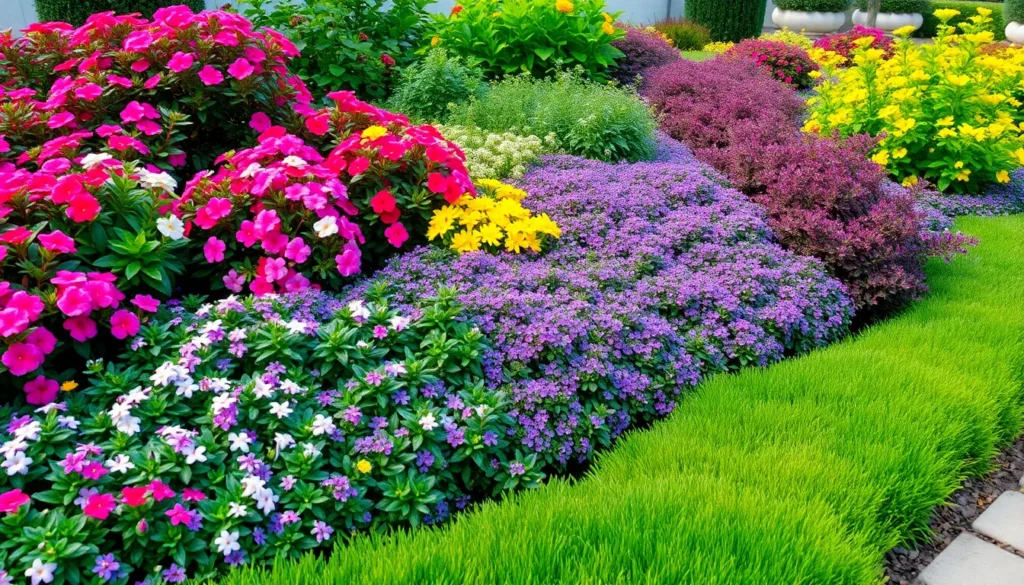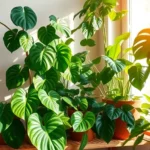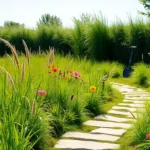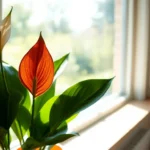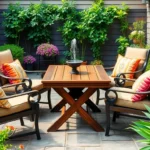We’ve all stared at those stubborn bare patches in our gardens wondering what magic solution could transform them into lush green spaces. Ground cover plants aren’t just nature’s carpet – they’re your secret weapon against weeds erosion and endless maintenance headaches.
Imagine walking through your garden where every inch blooms with purpose. Ground covers work tirelessly while you sleep choking out weeds retaining moisture and creating stunning visual interest that makes neighbors pause and admire. From creeping thyme that releases fragrance with every footstep to hardy pachysandra that thrives in deep shade these living carpets solve problems you didn’t even know you had.
We’re about to share game-changing ground cover ideas that’ll revolutionize how you think about garden design. Whether you’re dealing with steep slopes shady corners or high-traffic areas we’ve got answers that’ll make your outdoor space both beautiful and brilliantly low-maintenance.
Low-Growing Flowering Ground Covers for Color and Beauty
Flowering ground covers deliver stunning visual impact while maintaining the practical benefits we’ve discussed. These colorful options transform ordinary garden spaces into vibrant carpets that bloom throughout different seasons.
Creeping Phlox for Spring Blooms
Creeping phlox creates spectacular spring displays with dense mats of pink, purple, white, or blue flowers that completely cover the foliage. We recommend planting this hardy perennial in full sun locations where it can spread 12 to 18 inches wide while staying just 6 inches tall. The needle-like evergreen leaves provide year-round interest even after the blooming period ends in late spring.
This ground cover thrives in well-draining soil and requires minimal water once established. We’ve found it particularly effective on slopes and rock gardens where its spreading habit prevents erosion. Creeping phlox tolerates foot traffic moderately well and fills gaps between stepping stones beautifully.
Ajuga for Shade and Purple Spikes
Ajuga produces distinctive purple flower spikes that rise 4 to 6 inches above glossy, colorful foliage in late spring and early summer. We appreciate how this ground cover adapts to challenging shade conditions where many flowering plants struggle to perform. The bronze, burgundy, or variegated leaves create attractive patterns that persist throughout the growing season.
This fast-spreading perennial reaches 6 to 9 inches in height and can cover large areas quickly. We recommend ajuga for areas under trees, along walkways, or in woodland gardens where it forms dense colonies. The plant tolerates various soil types and moisture levels while requiring minimal maintenance once established.
Sedum Varieties for Drought Tolerance
Sedum varieties offer exceptional drought tolerance while producing clusters of yellow, pink, red, or white star-shaped flowers throughout summer and fall. We recommend low-growing types like ‘Dragon’s Blood’ sedum, which reaches only 2 to 4 inches tall but spreads vigorously with succulent red-tinged foliage. These hardy perennials store water in their thick leaves, making them perfect for xeriscaping and rocky areas.
Different sedum species bloom at various times, allowing us to create extended flowering displays. We’ve successfully used these ground covers on green roofs, between pavers, and in containers where other plants would struggle. Most varieties prefer full sun and well-draining soil but adapt to poor growing conditions that challenge traditional ground covers.
Evergreen Ground Covers for Year-Round Appeal

While flowering ground covers bring seasonal beauty, evergreen varieties deliver consistent visual interest throughout all four seasons. These reliable performers maintain their foliage even during winter months, ensuring your garden never looks bare or abandoned.
Pachysandra for Dense Shade Coverage
Pachysandra thrives in the deepest shade where most other plants struggle to survive. We recommend this woodland champion for areas under dense tree canopies or alongside north-facing walls where sunlight rarely penetrates. Its glossy evergreen leaves form thick mats that effectively suppress weeds while requiring minimal maintenance once established.
Moisture loving pachysandra prefers well-drained soil that stays consistently moist. Plant spacing of 6 to 12 inches apart allows for optimal coverage within two growing seasons. This hardy ground cover tolerates urban pollution and deer browsing, making it perfect for city gardens and suburban landscapes alike.
Vinca Minor for Reliable Spreading
Vinca Minor spreads quickly and reliably across both sunny and shaded areas with remarkable consistency. We’ve observed this periwinkle variety establish dense coverage in just one to two seasons, making it ideal for homeowners seeking fast results. Blue-purple flowers appear in spring, adding delicate color to the dark green foliage carpet.
Adaptability makes Vinca Minor suitable for slopes, under trees, and in challenging transition zones between sun and shade. It tolerates drought conditions once established while spreading through trailing stems that root at nodes. This vigorous growth habit covers large areas efficiently without becoming invasive like some other spreading ground covers.
Juniper Varieties for Slopes and Banks
Creeping Juniper excels on slopes and banks where erosion control becomes a primary concern. We recommend Juniperus horizontalis varieties for their low-growing habit and extensive root systems that stabilize soil effectively. These evergreen shrubs maintain their structure year-round while requiring virtually no maintenance once established.
Foliage colors range from silvery-blue to golden-yellow and rich green, depending on the exact cultivar you choose. Blue Rug Juniper stays under 6 inches tall while spreading 6 to 8 feet wide, perfect for covering large sloped areas. Drought tolerance and salt resistance make these junipers suitable for coastal gardens and areas with challenging growing conditions.
Native Ground Cover Plants for Eco-Friendly Gardens
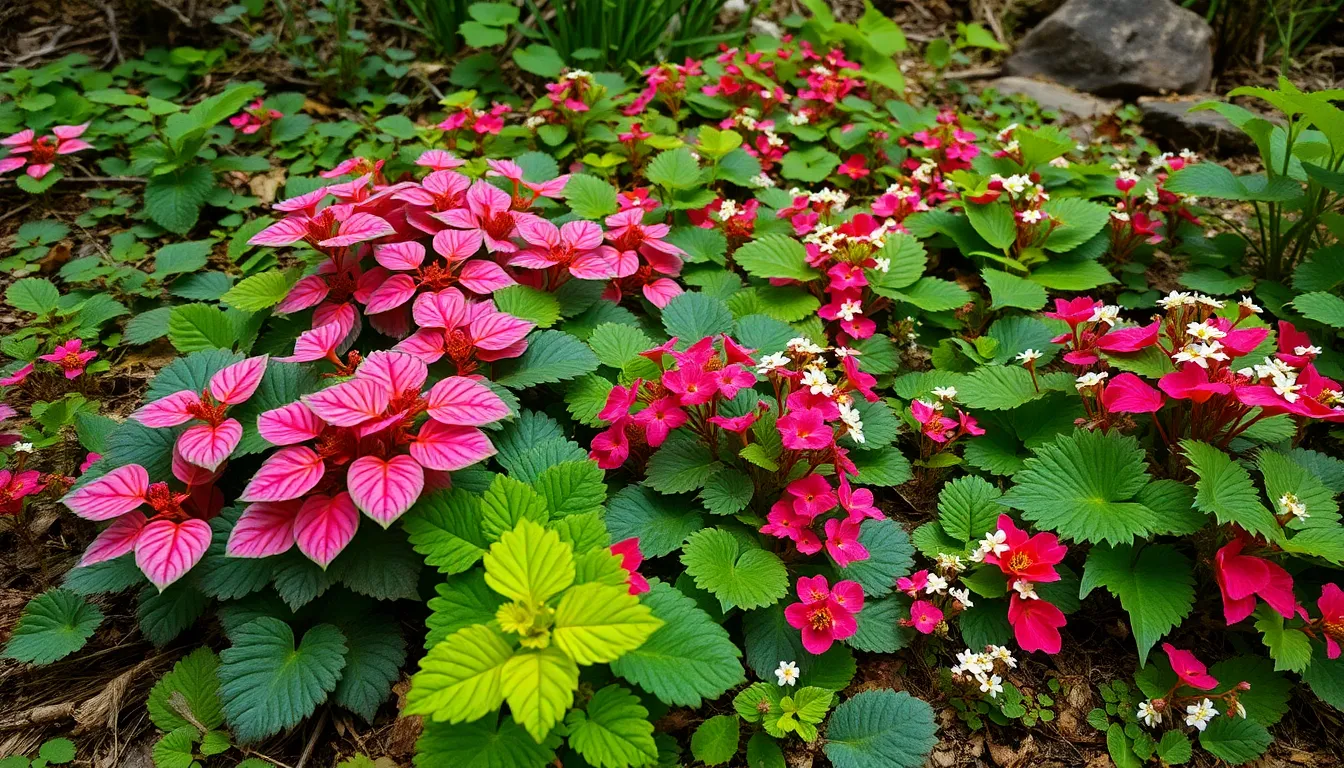
We’re shifting our focus to native ground cover options that enhance your garden’s sustainability while reducing environmental impact. These indigenous plants naturally thrive in local conditions and support beneficial wildlife populations.
Wild Ginger for Woodland Areas
Wild ginger (Asarum canadense) creates exceptional coverage in woodland gardens where traditional grass struggles to establish. This evergreen perennial produces distinctive heart shaped leaves that form dense carpets beneath tree canopies. We’ve observed how its low growing habit makes it perfect for shaded slopes and naturalized forest settings.
Spring brings small reddish brown flowers that bloom close to the ground, adding subtle interest to woodland areas. The plant’s ability to thrive in deep shade makes it an invaluable choice for challenging spots under mature trees. Wild ginger requires minimal maintenance once established and naturally suppresses competing weeds.
Coral Bells for Partial Shade
Coral bells (Heuchera spp.) offer vibrant foliage colors that brighten partially shaded garden areas throughout the growing season. These versatile perennials display maple like leaves in stunning shades of pink, red, purple, and chartreuse. We recommend planting multiple varieties together to create ever-changing color combinations.
Delicate flower spikes emerge in late spring and early summer, attracting hummingbirds and beneficial pollinators to your garden space. The plants maintain their attractive appearance from spring through fall, providing consistent visual interest. Coral bells adapt well to various soil conditions and require only occasional watering once established.
Beach Strawberry for Coastal Regions
Beach strawberry (Fragaria chiloensis) excels in coastal environments where salt spray and sandy soils challenge other ground covers. This spreading perennial produces small white flowers in spring that develop into edible strawberries throughout summer months. We’ve seen how its trailing growth habit effectively controls erosion on coastal slopes.
The plant’s thick, glossy leaves resist salt damage and maintain their appearance even though harsh coastal conditions. Beach strawberry creates dense mats that suppress weeds while providing habitat for beneficial insects. This native option requires minimal irrigation once established, making it ideal for water conscious coastal gardening.
Fast-Spreading Ground Covers for Quick Coverage
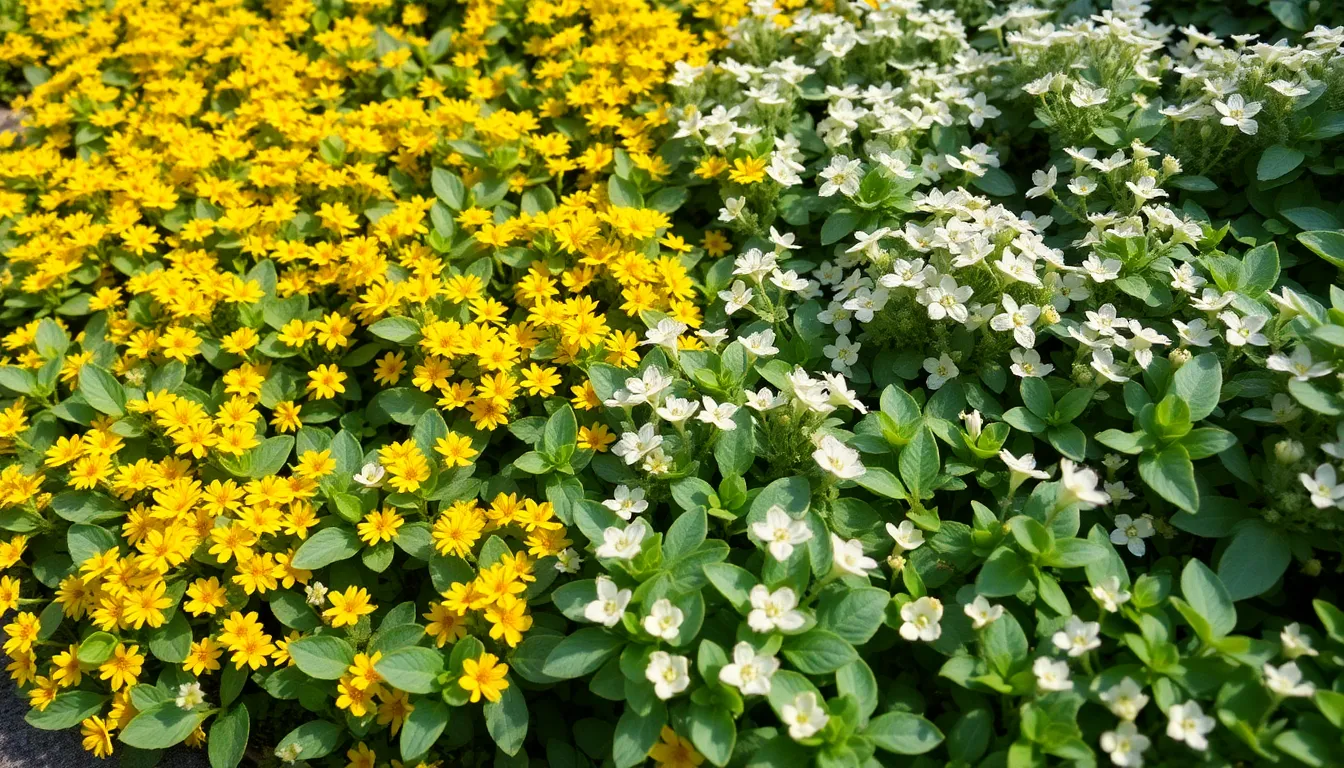
When we need rapid ground coverage, these aggressive spreaders deliver exceptional results in just one growing season. We’ve selected varieties that establish quickly while providing long-term beauty and functionality.
Creeping Jenny for Moist Areas
Creeping Jenny transforms waterlogged spaces into golden carpets with its fast-spreading, coin-shaped leaves. This vigorous spreader thrives in consistently moist environments where other plants struggle, making it perfect for rain gardens, pond edges, and low-lying areas. We recommend monitoring its growth since it can quickly colonize adjacent areas when conditions are ideal.
Golden yellow foliage brightens shaded corners while providing excellent weed suppression through dense coverage. Container gardening works well for controlling its spread while still enjoying its cascading beauty in hanging baskets or spillover plantings.
Lamb’s Ear for Silver Foliage
Lamb’s Ear creates stunning silver contrasts in sunny gardens with its distinctive velvety texture and rapid spreading habit. These soft, fuzzy leaves form thick mats that reflect light beautifully while requiring well-drained soil conditions to prevent moisture-related issues. We’ve found it particularly effective in Mediterranean-style gardens and xeriscaping projects.
Purple flower spikes emerge in summer, adding vertical interest above the silvery carpet. Deer resistance makes this ground cover ideal for rural properties where wildlife browsing poses challenges for other plantings.
Sweet Woodruff for Fragrant Carpets
Sweet Woodruff develops into fragrant carpets perfect for shaded woodland areas with its delicate white spring flowers and sweet hay-like scent. This low-maintenance spreader creates dense mats that effectively suppress weeds while releasing pleasant aromas when walked upon or brushed against. We particularly appreciate its ability to thrive under trees where grass struggles.
Star-shaped leaves provide interesting texture throughout the growing season, turning attractive shades in fall. Traditional uses include potpourri and herbal teas, making this ground cover both ornamental and potentially useful for crafting enthusiasts.
Drought-Tolerant Ground Covers for Water-Wise Landscaping
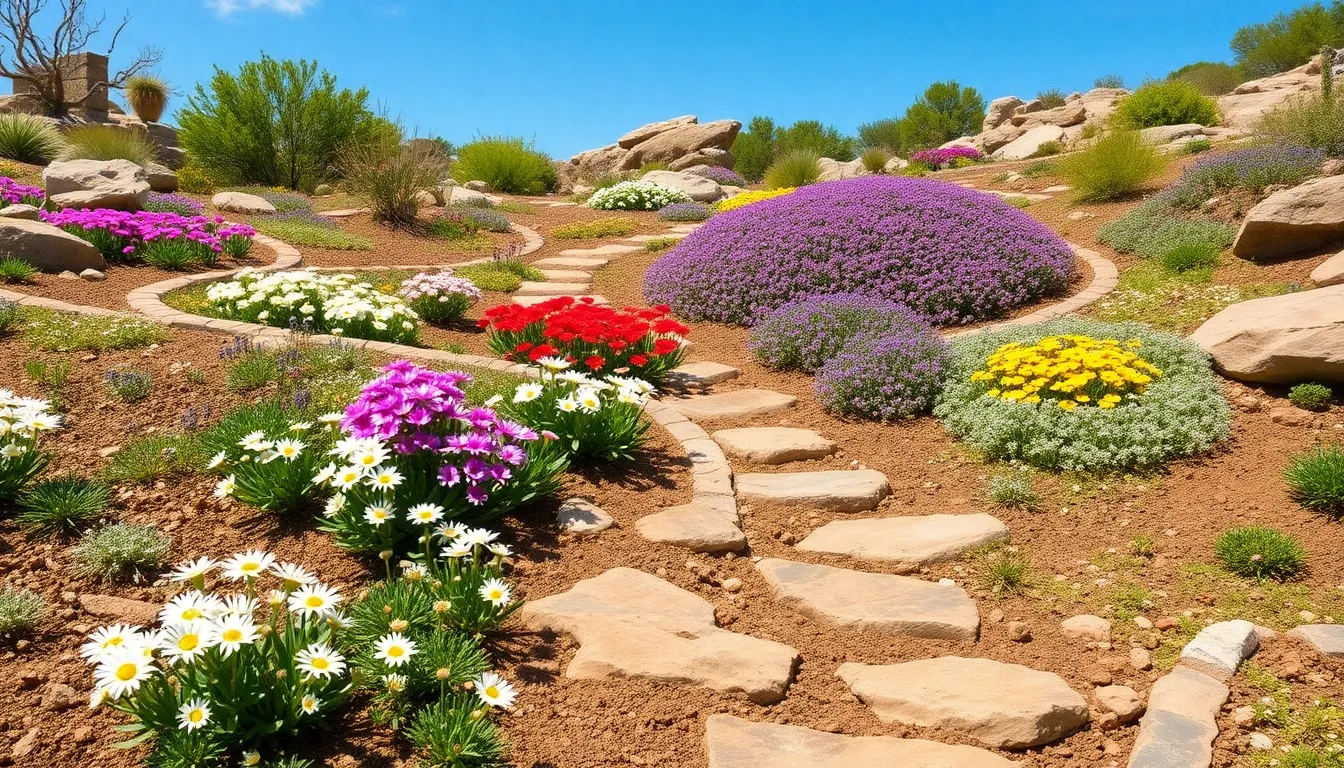
We’ve explored various ground cover options, but drought-tolerant varieties deserve special attention for their water-saving capabilities. These resilient plants transform challenging dry areas into stunning landscapes while reducing irrigation needs.
Ice Plant for Hot, Dry Slopes
Ice plant excels at creating vibrant displays on challenging terrain where other plants struggle to survive. This remarkable succulent produces brilliant, daisy-like flowers in shades of pink, purple, yellow, and orange that bloom throughout the growing season.
We recommend ice plant for slopes exceeding 15 degrees where erosion control becomes critical. Its thick, fleshy leaves store water efficiently, allowing the plant to thrive with minimal rainfall. The spreading habit creates dense mats that prevent soil erosion while requiring virtually no maintenance once established.
Sandy soils and coastal conditions provide ideal growing environments for ice plant varieties. These plants handle salt spray, intense sun, and poor drainage better than most alternatives. Their ability to retain moisture internally makes them perfect for xeriscaping projects where water conservation remains the primary goal.
Thyme Varieties for Walkable Surfaces
Thyme varieties create fragrant, durable carpets that withstand moderate foot traffic while releasing pleasant aromas. Creeping thyme forms dense mats reaching only 2-3 inches in height, making it ideal for pathways between stepping stones or as lawn alternatives in small spaces.
We’ve found that woolly thyme and elfin thyme perform exceptionally well in drought conditions while maintaining their compact growth habit. These varieties produce tiny flowers in white, pink, or purple that attract beneficial pollinators throughout summer months. Their drought tolerance stems from their Mediterranean origins, where they’ve adapted to survive long, dry summers.
Regular foot traffic actually benefits thyme ground covers by promoting denser growth and releasing essential oils. The plants recover quickly from compression and continue spreading to fill gaps naturally. Their aromatic properties also help deter certain garden pests while creating sensory garden experiences.
Stonecrop for Rocky Gardens
Stonecrop varieties showcase exceptional adaptability to challenging growing conditions where soil depth remains limited. These succulent perennials store water in their thick leaves, enabling them to flourish in rocky crevices, stone walls, and gravelly soils where other plants cannot establish roots.
We recommend sedum varieties like ‘Dragon’s Blood’ and ‘Red Carpet’ for their vibrant foliage colors that intensify during stress periods. These low-growing types spread rapidly through underground runners while maintaining heights under 4 inches. Their star-shaped flowers appear in late summer, providing nectar sources when many other plants have finished blooming.
Different stonecrop species offer varying textures and growth habits for diverse design applications. Groundhugging varieties work perfectly between flagstones, while slightly taller species create textural contrast in rock gardens. Their ability to thrive without supplemental watering once established makes them invaluable for water-wise landscaping projects in challenging locations.
Shade-Loving Ground Covers for Problem Areas
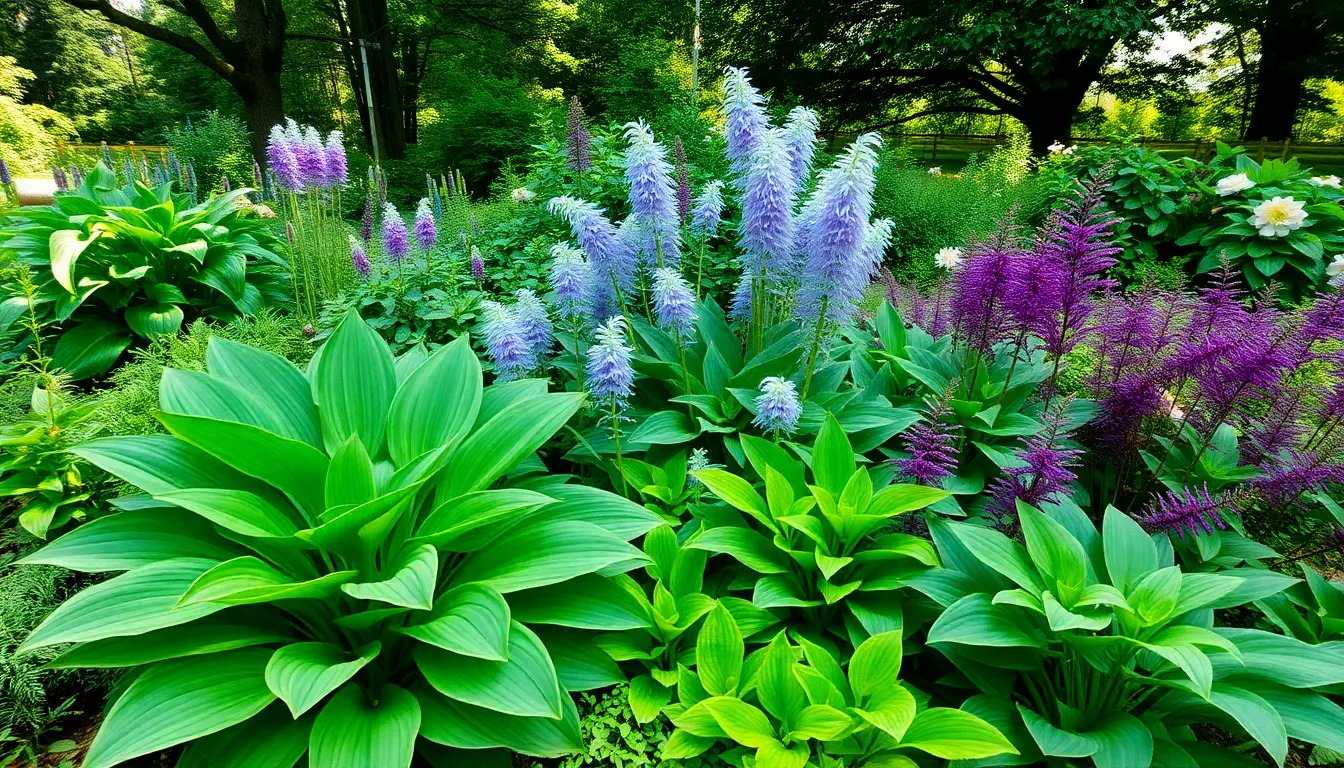
We’ve discovered that shaded areas often present unique challenges, but these hardy ground covers transform even the most difficult spots into lush garden features. Problem areas beneath dense tree canopies or along north-facing walls become beautiful landscapes with the right plant selections.
Hostas for Lush Foliage
Hostas create stunning focal points while serving as effective ground cover in our shaded garden spaces. These classic shade plants offer rich foliage varieties in multiple sizes and colors, from compact miniatures to architectural giants. We love how their broad leaves suppress weeds naturally while providing consistent visual appeal throughout the growing season. Heart-shaped, lance-shaped, and rounded leaf forms give us endless design possibilities, while variegated patterns in gold, white, and green add brightness to dim corners. Deer resistance makes hostas particularly valuable in areas where wildlife browsing creates ongoing maintenance challenges.
Japanese Spurge for Deep Shade
Japanese Spurge (Pachysandra terminalis) thrives in the deepest shade where most other plants fail completely. Dense mats of glossy evergreen leaves form quickly, creating uniform coverage that requires minimal maintenance once established. We find this ground cover particularly effective under mature trees where soil moisture and light levels challenge other plant options. Its ability to spread through underground rhizomes means we get consistent coverage without gaps or bare patches. Problem areas that receive less than two hours of direct sunlight daily become transformed into neat, professional-looking landscapes with Japanese Spurge installations.
Astilbe for Textural Interest
Astilbe adds feathery plumes and handsome foliage that create dramatic textural contrasts in our shaded ground cover plantings. These perennials offer plume colors ranging from white and pink to deep red and purple, providing seasonal interest beyond their attractive leaves. We appreciate how Astilbe varieties come in different heights, allowing us to layer plantings for maximum visual impact. Moisture-loving characteristics make these plants perfect for rain gardens or naturally damp areas where other ground covers struggle. Their clumping growth habit creates natural drifts that look established and mature within just one or two growing seasons.
Edible Ground Covers for Functional Beauty
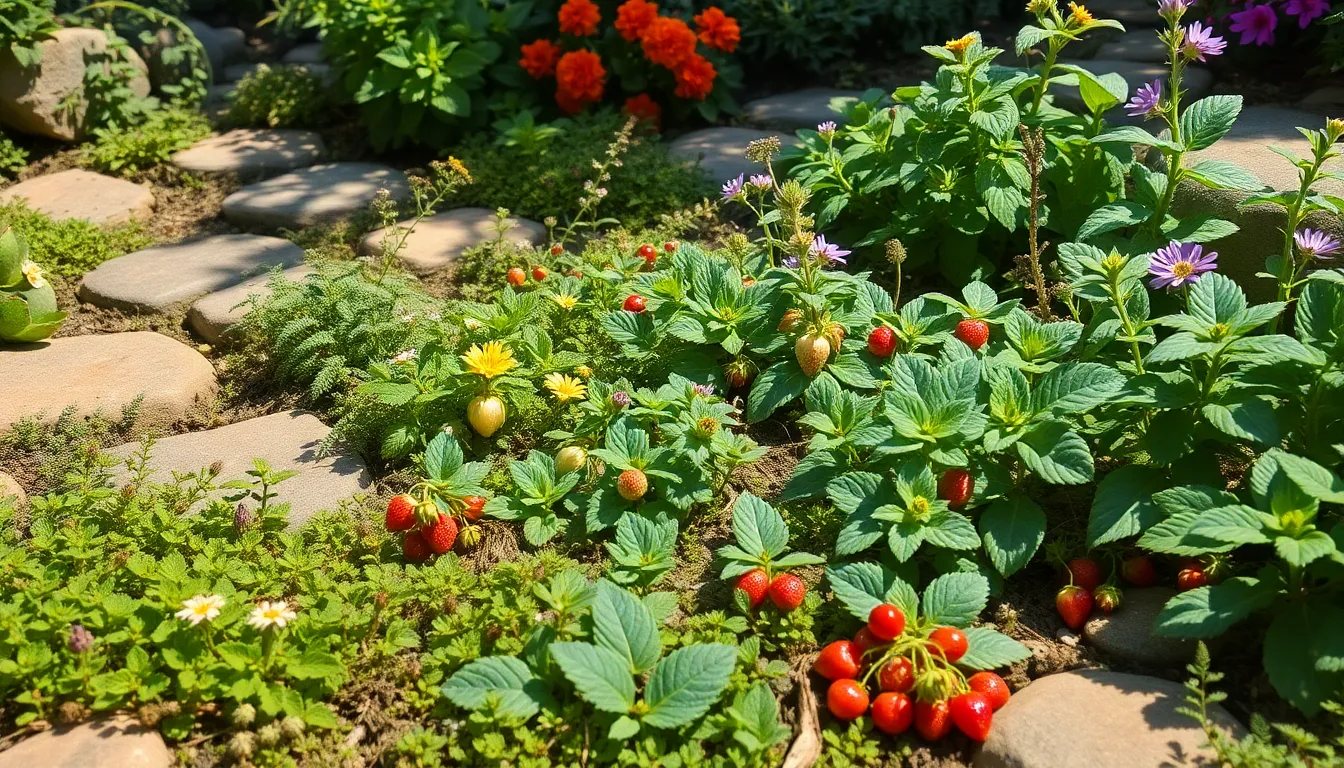
Transform your garden into a productive industry with ground covers that offer both visual appeal and culinary rewards. These edible options provide the same weed suppression and soil protection as traditional varieties while delivering fresh herbs and fruits for your kitchen.
Creeping Oregano for Culinary Use
Creeping oregano delivers exceptional versatility as a drought-tolerant ground cover that enhances your culinary experience. This aromatic herb particularly benefits members of the Brassicaceae family like broccoli and cabbage by repelling sap-sucking insects naturally. Regular harvesting keeps the plant compact and encourages dense growth, making it perfect for bordering pathways or garden beds. We recommend planting creeping oregano in sunny locations where it’ll spread steadily while providing fresh herbs for Italian dishes, pizza toppings, and Mediterranean cuisine throughout the growing season.
Wild Strawberries for Sweet Treats
Wild strawberries create an exceptional edible ground cover that produces sweet, nutritious fruits while spreading quickly across large areas. These hardy plants thrive in partial shade and enhance soil health through their natural root systems. We’ve found that wild strawberries excel at suppressing weeds while offering continuous harvests of small, intensely flavored berries perfect for desserts, salads, and fresh snacking. Their white flowers add seasonal beauty before transforming into the coveted red fruits that attract beneficial wildlife to your garden network.
Mint Varieties for Aromatic Coverage
Mint varieties like spearmint and peppermint provide rapid-spreading aromatic coverage that serves multiple garden functions. These vigorous growers excel at soil coverage while offering fresh leaves for teas, cocktails, desserts, and savory dishes year-round. We suggest containing mint in designated areas since its invasive nature can overwhelm neighboring plants, but this same aggressive spreading makes it ideal for problem areas where other ground covers struggle. Beyond culinary uses, mint naturally repels ants, rodents, and other garden pests while releasing refreshing fragrances when walked upon or brushed against.
| Ground Cover | Growth Rate | Light Requirements | Culinary Uses |
|---|---|---|---|
| Creeping Oregano | Moderate | Full sun | Italian dishes, pizza, Mediterranean cuisine |
| Wild Strawberries | Fast | Partial shade | Desserts, salads, fresh eating |
| Mint Varieties | Very fast | Partial sun to shade | Teas, cocktails, desserts |
Additional edible options include sweet potato vines that provide lush coverage along with edible tubers and leaves while aiding in natural pest management. Other varieties like thyme, chamomile, and clover offer culinary and medicinal benefits while improving garden biodiversity and supporting beneficial insects throughout the growing season.
Ornamental Grass Ground Covers for Modern Appeal
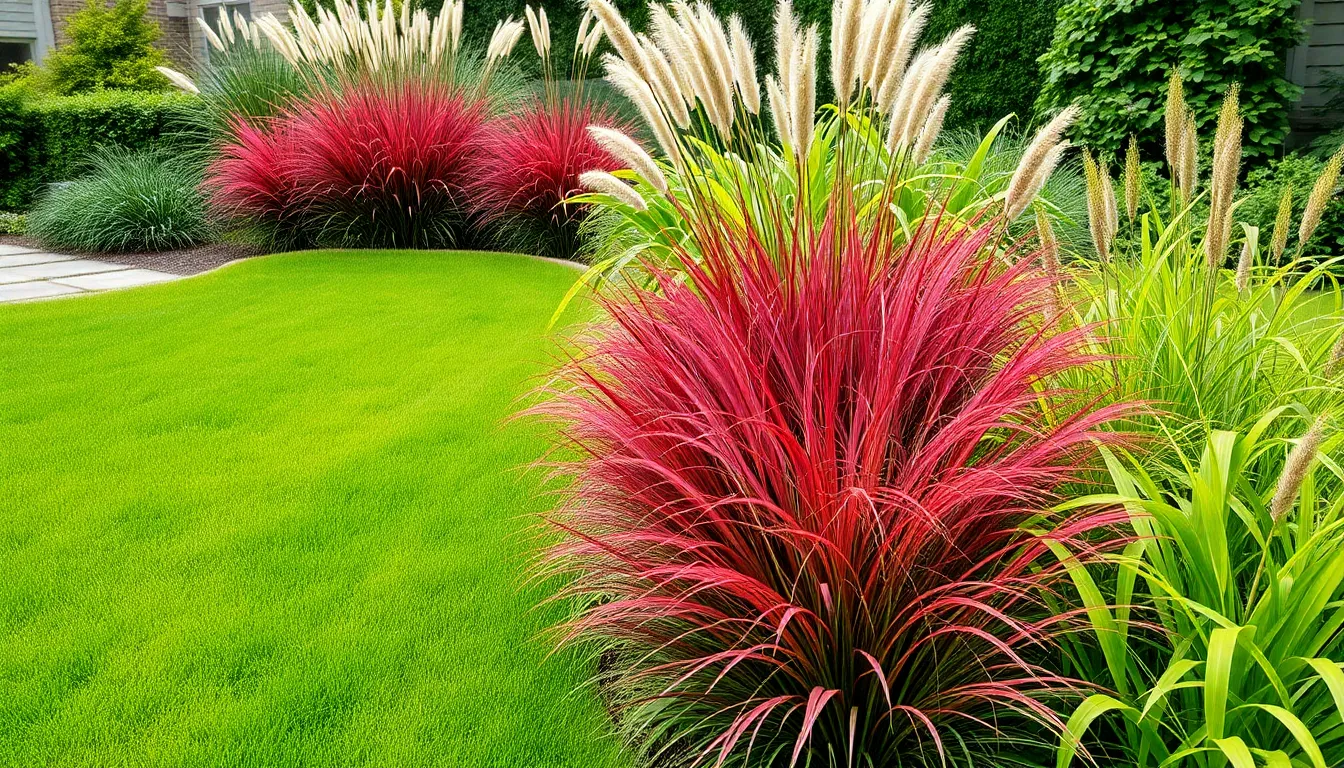
Ornamental grasses bring contemporary sophistication to traditional ground cover approaches while requiring minimal maintenance. These versatile plants create striking architectural elements that complement modern industry designs perfectly.
Mondo Grass for Clean Lines
Dwarf Mondo Grass delivers exceptional performance as our top choice for creating precise, manicured edges in contemporary gardens. This compact variety thrives in both full sun and deep shade conditions, making it incredibly versatile for various industry situations. We recommend using it along walkways and borders where its linear growth pattern creates sharp, professional looking boundaries.
Dense clumps form naturally over time, creating uniform coverage that suppresses weeds effectively. The evergreen foliage maintains its deep green color throughout winter months, providing consistent visual appeal when other plants go dormant.
Buffalo Grass for Lawn Alternatives
Buffalo Grass serves as our preferred native alternative to traditional turf grass for homeowners seeking sustainable landscaping answers. This drought resistant species requires significantly less water than conventional lawns, making it ideal for xeriscaping and water conservation efforts. We’ve observed that established Buffalo Grass can survive extended dry periods without supplemental irrigation.
Maintenance demands drop considerably compared to regular grass varieties since this native species grows slowly and requires infrequent mowing. The fine textured blades create an attractive carpet appearance while supporting local wildlife populations naturally.
Sedge Varieties for Wet Areas
Japanese Sedge and Ice Dance Sedge excel in moisture rich environments where traditional ground covers often struggle or fail completely. These hardy varieties thrive in areas with consistent dampness, creating attractive foliage displays that add texture and visual interest to challenging wet spots. We particularly appreciate how these sedges handle seasonal flooding without showing stress or damage.
The graceful arching habit of these varieties creates movement in the industry while their dense root systems help prevent soil erosion in problematic wet areas. Year round appeal comes from their evergreen nature and ability to maintain attractive appearance even during challenging weather conditions.
Ground Covers for Specific Garden Challenges
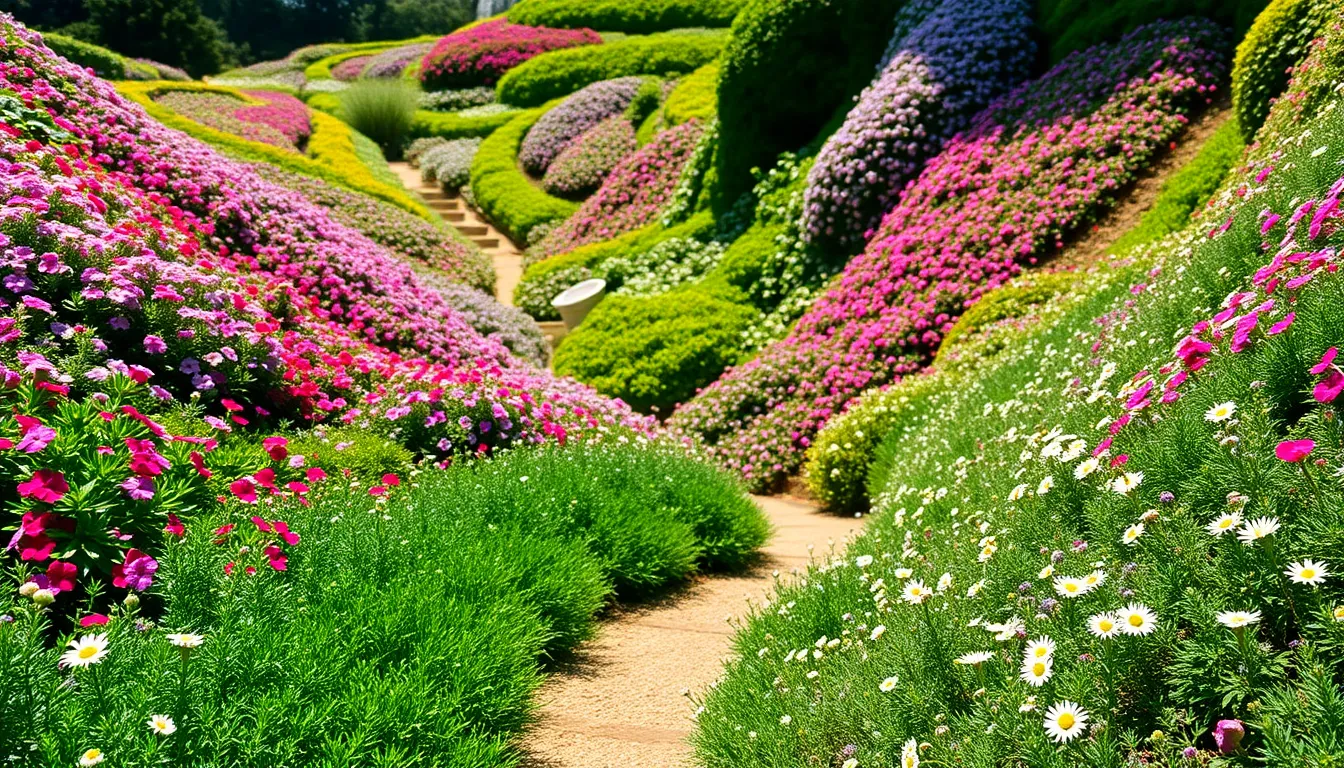
Tackling unique landscaping challenges requires strategic plant selection that addresses both practical needs and aesthetic goals. We’ll explore targeted answers for three common problem areas where standard ground covers often struggle.
Steep Slope Answers
Creeping Juniper transforms unstable slopes into secure, evergreen landscapes through its natural spreading habit and deep root system. This hardy shrub establishes strong soil-binding networks as it grows horizontally, making it our top choice for erosion-prone areas.
Sedum varieties excel on steep terrain with their succulent water-storing capabilities and robust root structures that anchor loose soil. These drought-tolerant champions require minimal establishment care while providing colorful seasonal blooms and year-round texture.
Creeping Phlox creates spectacular spring displays with dense flowering mats that thrive in full sun and rocky conditions. Though slower to establish than other options, this perennial forms incredibly effective soil-stabilizing networks once mature.
Ice Plant (Delosperma) delivers vibrant daisy-like flowers while conquering hot, sunny slopes with exceptional drought resilience. Once established, this succulent perennial requires virtually no supplemental watering and provides excellent erosion control.
Periwinkle (Vinca minor) offers vigorous evergreen coverage for gentler slopes in shaded to partially sunny locations. While highly effective at soil stabilization, we recommend checking local invasive species guidelines before planting in sensitive ecosystems.
Under Tree Plantings
Sweet Woodruff thrives in the challenging conditions beneath tree canopies, producing fragrant foliage and delicate white flowers in deep shade. This low-growing perennial tolerates root competition while creating dense, weed-suppressing mats in moist woodland settings.
Hosta varieties form substantial clumps with striking foliage patterns that brighten shaded areas where few other plants succeed. These reliable perennials adapt to various shade levels and soil moisture conditions, making them versatile answers for under-tree challenges.
Ajuga (Bugleweed) combines colorful bronze, purple, or variegated leaves with distinctive blue flower spikes that emerge in spring. This adaptable ground cover spreads steadily in shade while tolerating the dry conditions often found beneath established trees.
Epimedium (Barrenwort) excels in dry shade situations where tree roots create challenging growing conditions for most plants. These elegant perennials produce heart-shaped leaves and delicate spring flowers while requiring minimal maintenance once established.
Hens and Chicks (Sempervivum) succeed in filtered light conditions where tree canopies create dappled shade patterns. These architectural succulents form interesting rosette colonies while tolerating the periodic drought stress common in tree root zones.
Between Stepping Stones
Creeping Thyme releases delightful herbal fragrances with each footstep while tolerating light foot traffic and drought conditions. This aromatic ground cover fills pathway gaps beautifully and produces tiny flowers that attract beneficial pollinators throughout the growing season.
Irish Moss creates soft, cushion-like surfaces perfect for cool climate pathways and shaded stepping stone areas. This moss-like perennial forms dense, emerald green mats that feel pleasant underfoot and maintain their appearance with minimal care.
Dwarf Chamomile emits sweet apple-like scents when walked upon, making pathway navigation a sensory experience. This durable option handles moderate foot traffic while producing tiny white flowers that complement traditional garden aesthetics.
Blue Star Creeper spreads rapidly to fill gaps between stones with tiny star-shaped blue flowers and fine-textured foliage. This versatile ground cover adapts to full sun through partial shade conditions while tolerating occasional foot traffic.
Creeping Jenny brightens pathway edges with chartreuse yellow-green foliage that creates striking contrasts against stone surfaces. This adaptable perennial fills spaces quickly and thrives in various moisture conditions, from dry to consistently moist soils.
Conclusion
We’ve explored an impressive array of ground cover options that can transform any garden space into a thriving low-maintenance industry. From drought-tolerant sedums to shade-loving hostas and edible oregano these versatile plants offer answers for every gardening challenge you might face.
The key to success lies in matching the right ground cover to your exact conditions whether you’re dealing with steep slopes wet areas or deep shade. With proper selection these hardworking plants will reward you with years of beauty while reducing maintenance demands.
Start small with one area and gradually expand as you discover which varieties thrive in your unique garden environment. Your patience will pay off as these remarkable plants establish themselves and create the lush carpet effect you’re seeking.
Frequently Asked Questions
What are the main benefits of using ground cover plants in gardens?
Ground cover plants transform bare patches into vibrant, low-maintenance spaces while providing multiple benefits. They effectively combat weeds by creating dense coverage, retain soil moisture to reduce watering needs, and enhance visual appeal year-round. Additionally, they help prevent soil erosion on slopes and reduce the need for frequent garden maintenance compared to traditional grass lawns.
Which ground covers work best for shady areas?
Several excellent ground covers thrive in shade, including Pachysandra for dense shade under trees, Ajuga with its colorful foliage and purple flower spikes, and Wild Ginger for woodland areas. Hostas offer stunning foliage and deer resistance, while Sweet Woodruff creates fragrant, dense mats. These shade-tolerant options require minimal maintenance while suppressing weeds effectively.
What are the best drought-tolerant ground covers for water-wise landscaping?
Top drought-tolerant ground covers include Sedum varieties with their vibrant star-shaped flowers, Ice Plant for hot slopes with colorful blooms, and various Thyme species that are aromatic and walkable. Creeping Juniper provides excellent erosion control, while Stonecrop thrives in rocky conditions. These plants require minimal water once established and excel in challenging growing conditions.
Which ground covers spread quickly for fast coverage?
Fast-spreading ground covers include Creeping Jenny, which creates golden carpets in moist areas, and Lamb’s Ear with its silver foliage for sunny gardens. Vinca Minor spreads rapidly in both sun and shade, while Sweet Woodruff quickly establishes dense coverage in woodland settings. These varieties provide quick results while maintaining long-term beauty and functionality.
Are there edible ground covers that provide both beauty and food?
Yes, several ground covers offer culinary benefits alongside aesthetic appeal. Wild strawberries produce sweet fruits while enhancing soil health, and Creeping Oregano provides herbs while repelling pests. Mint varieties grow rapidly and offer aromatic leaves for cooking. Sweet potato vines, Thyme, Chamomile, and Clover also provide edible benefits while supporting garden biodiversity.
What ground covers work best for steep slopes and erosion control?
For steep slopes, choose Creeping Juniper for its excellent erosion control and drought resistance, Sedum varieties for their resilience, and Ice Plant for hot, dry conditions. These ground covers establish strong root systems that stabilize soil while requiring minimal maintenance. They’re particularly effective in challenging locations where traditional plants might struggle to establish.
Which ground covers are suitable for filling gaps between stepping stones?
Ideal stepping stone fillers include Creeping Thyme, which releases fragrance when stepped on and tolerates foot traffic, Irish Moss for its soft, cushion-like appearance, and Blue Star Creeper with its tiny blue flowers. These low-growing options enhance pathway aesthetics while withstanding occasional foot traffic and providing functional beauty between pavers.
What evergreen ground covers provide year-round interest?
Evergreen ground covers that maintain visual appeal year-round include Pachysandra for shaded areas under trees, Vinca Minor for its adaptability to various light conditions, and Creeping Juniper varieties for slopes and banks. These plants provide consistent green coverage through all seasons, requiring minimal maintenance while offering reliable landscape structure and color.

